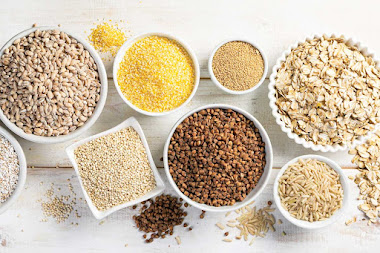Eat whole grains for smaller increases in waist size, blood pressure, and blood sugar.
Eat whole grains for smaller increases in waist size, blood pressure, and blood sugar.
Study in the middle- to older-aged adults suggests whole grains may protect against heart disease.
Middle- to older-aged adults who ate at least three servings of whole grains daily had smaller increases in waist size, blood pressure, and blood sugar levels over time compared to those who ate less than a one-half serving per day, according to new research.
Published July 13, 2021, in the Journal of Nutrition, the study by researchers at the Jean Mayer USDA Human Nutrition Research Center on Aging at Tufts University examined how whole- and refined-grain intake over time impacted five risk factors of heart disease: Waist size, blood pressure, blood sugar, triglyceride, and HDL ("good") cholesterol.
Using data from the Framingham Heart Study Offspring Cohort, which began in the 1970s to assess long-term risk factors of heart disease, the new research examined health outcomes associated with whole- and refined-grain consumption over a median of 18 years. The 3,100 participants from the cohort were mostly white and, on average, in their mid-50s at the start of data collection.
The research team compared changes in the five risk factors, over four-year intervals, across four categories of reported whole grain intake, ranging from less than a half serving per day to three or more servings. According to the Dietary Guidelines for Americans 2020-2025, the recommended amount of whole grains is three or more servings daily. An example of a serving is one slice of whole-grain bread, a half cup of rolled oats cereal, or a half-cup of brown rice.
The results showed that for each four-year interval:
Waist size increased by an average of over 1 inch in the low intake participants versus about ½ inch in the high intake participants.
Even after accounting for changes in waist size, average increases in blood sugar levels and systolic blood pressure were greater in low intake participants than high intake participants.
The researchers also studied the five risk factors across four categories of refined-grain intake, ranging from less than two servings per day to more than four servings per day. Lower refined-grain intake led to a lower average increase in waist size and a greater mean decline in triglyceride levels for each four-year period.
"Our findings suggest that eating whole-grain foods as part of a healthy diet delivers health benefits beyond just helping us lose or maintain weight as we age. In fact, these data suggest that people who eat more whole grains are better able to maintain their blood sugar and blood pressure over time. Managing these risk factors as we age may help to protect against heart disease," said Nicola McKeown, senior and corresponding author and a scientist on the Nutritional Epidemiology Team at the USDA HNRCA.
"There are several reasons that whole grains may work to help people maintain waist size and reduce increases in the other risk factors. The presence of dietary fiber in whole grains can have a satiating effect, and the magnesium, potassium, and antioxidants may contribute to lowering blood pressure. Soluble fiber in particular may have a beneficial effect on post-meal blood sugar spikes," said Caleigh Sawicki. Sawicki did this work as part of her doctoral dissertation while a student at the Gerald J. and Dorothy R. Friedman School of Nutrition Science and Policy at Tufts University and working with the Nutritional Epidemiology Team at the USDA HNRCA.
The greatest contributor to whole-grain intake among participants was whole-wheat bread and ready-to-eat whole-grain breakfast cereals. The refined grains came mostly from pasta and white bread. The difference in health benefits between whole and refined grains may stem from the fact that whole grains are less processed than refined grains. Whole grains have a fiber-rich outer layer and an inner germ layer packed with B vitamins, antioxidants, and small healthy fats. Milling whole grains removes these nutrient-dense components, leaving only the starch-packed refined grain behind.
"The average American consumes about five servings of refined grains daily, much more than is recommended, so it's important to think about ways to replace refined grains with whole grains throughout your day. For example, you might consider a bowl of whole-grain cereal instead of a white flour bagel for breakfast and replacing refined-grain snacks, entrees, and side dishes with whole-grain options. Small incremental changes in your diet to increase whole-grain intake will make a difference over time," McKeown said.
Methodology
To measure daily grain intake, the researchers used diet questionnaires that participants completed every four years from 1991 to 2014, resulting in a median of 18 years of data.
Dietary assessment data came from five study examinations, and observations were only included if participants attended at least two consecutive examinations with accurate dietary data. Participants with diabetes at baseline were excluded.
The statistical analysis was adjusted for factors that might influence the results, including other aspects of a healthy diet. Limitations of the study include the fact that food consumption is self-reported, and participants may over-or under-estimate intake of certain foods based on perceived social desirability. In addition, due to its observational design, the study does not reflect a causal relationship.




Comments
Post a Comment